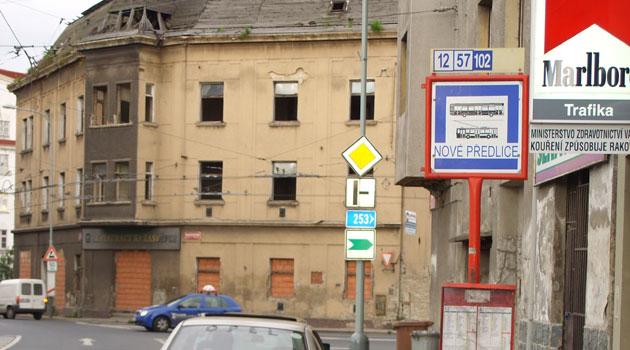The town of Ústí nad Labem wants to transform the ghetto of Předlice, where two years ago a young woman was killed when a building collapsed, into a recreation zone. Is this a realistic vision?
Does the town even know where those now residing in the ghetto will move? "The more investors we attract into Předlice, the more expensive the apartments and houses there will become. Logically, they will be too expensive for the people who live there now. They will simply have to move to the next building over," explains Vice-Mayor Karel Karika (Pro!Ústí) of the Ústí-střed Municipal Department to news server Romea.cz.
When asked what he meant by "the next building over" and whether it won’t be difficult for Romani people and other ghetto residents to find new homes, he adds that "there are enough apartments here. The current situation of trafficking in poverty at the residential hotels is unacceptable."
According to Karika, the plan to tranform the ghetto has the support of most people at the Ústí town hall. Statements made by Mayor of Ústí nad Labem Josef Zikmund (ANO 2011) testify to that; Zikmund undertook an "inspection trip" of Předlice at the end of last year and also spoke of the need to attract investors and completely transform it.
"We will seek available financing and also an appropriate subsidy to clean up the neighborhood and get rid of these ruins. It would be good to tear it all down at once so the homeless don’t just move from building to building," Zikmund said.
Is the Mayor predictively labeled the current local residents as homeless? His approach differs from Karika’s vision in only one point – he doesn’t want these people moving into "the next building."
Raze it to the ground and bring in the tourists
The vision that counts on razing the ghetto to the ground is naturally a tempting one. What else could be done with it?
The buildings there are dilapidated, with some at risk of burying their inhabitants under their own collapsed walls. Two years ago a young Romani woman, the mother of two children, perished in just such a collapsed building.
Back then a great deal was said and written about Předlice in connection with the removal of other Romani residents out of other buildings that were falling apart. Of course, it also seemed that there were not enough apartments nearby for them to move into.
Saša Uhlová described the situation in an excellent reportage. She reminded readers of the roots of the problem in Předlice.
The first Romani residents began to move in there during the 1980s after the original residents were relocated to a new housing estate. The next wave of Romani people arrived after 1989.
At the same time, the "wild privatization" began of the neighborhood’s buildings which has resulted in today’s basically intractable situation. Jan Černý, who observed this all in his role as director of the Ústí branch of the People in Need organization, describes it like this in Uhlová’s reportage: "A firm from Prague bought up some of the neighborhood en bloc. One whole section. He was a small guy in red boots with six telephones on him. Then he just sold the apartments right there on the street. People had to give him money and he would sign contracts with them on the hood of his car. Some were purchased by locals and some were bought by an organized group from Dvůr Králové. They took out loans in other people’s names using these buildings and fraudulent, phoney appraisals of them. Now the situation is such that technically nothing can be done about it. These ruins have been pawned to the bank and the owner is someone who is either beyond prosecution or already in prison."
So – what is to be done? Simply, "attract investors", "clean it up" and raze the buildings.
According to Karika, a recreational zone could be created in Předlice for the accommodation of toursits traveling to nearby Lake Milada. Is that realistic, given the reputation of the ghetto in its current form?
"If enough investors are found who believe in this as much as I do, then it is realistic," Karika says. "It’s logical – today they can buy a ruined building for CZK 30 000 and in a couple of years sell it for CZK 2 million. It’s an ideal investment."
Even Boris Rudý isn’t crazy
Karika claims that part of the town’s plan for the transformation of Předlice includes the construction of hundreds of "social apartments". It is not clear whether those apartments will be ready once the others start to be too expensive for today’s local residents.
It is not clear under what conditions they will be available and to whom. It is also not clear where they will be.
According to the Vice-Mayor, what is clear is that a person like Boris Rudý would prefer to accommodate tourists than house ghetto residents. Rudý is a remowned figure in the ghetto – he has bought three buildings there, performed basic repairs to them, and is offering them as affordable housing.
"Today we are glad of Boris Rudý, at least the buildings won’t continue to deteriorate, but it’s clear that we want to get proper investors in here who will modernize the buildings," says Karika. "I think he’s not stupid and in time he will grasp the situation he’s in and he will offer his buildings for recreational purposes or as seasonal apartments. Only a crazy person wouldn’t do that."
The vision is clear, and it’s hard to object to it: A dilapidated ghetto will be transformed into a pleasant recreational zone. Only a crazy person wouldn’t do it!
Perhaps the only problem is that it is far from clear what will happen with the current ghetto residents. Can things get any worse for them?
